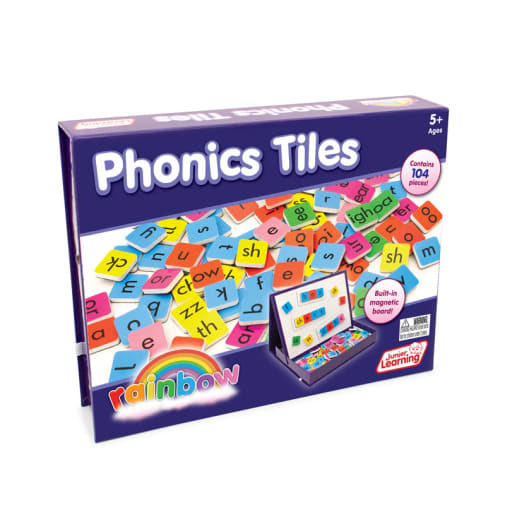Rather than foam letters, the Phonics Tiles are smaller, squarish magnetic tiles for word-building. Consonants, vowels, digraphs are all color-coded and come in a storage box with pop-up magnetic whiteboard along with phoneme frames.
Rainbow Phonics Tiles
SKU
020566
Grade PK-2
Neutral
Non-Consumable
These icons are designed to help you quickly understand and learn important information about our products.
Teaching Method
Traditional
Teacher-centered curriculum commonly used in classrooms that may include a text, teacher manual, tests, etc.
Charlotte Mason
A methodology based on the work of a 19th century educator who maintained that children learn best from literature (Living Books), not textbooks.
Classical
A methodology based on the Latin Trivium (three stages of learning), including the grammar stage (memorization and facts), logic stage (critical thinking), and rhetoric stage (developing/defending ideas).
Unit Study
A thematic or topical approach centered around one topic that integrates multiple subject areas.
Montessori (Discovery)
A methodology based on the work of a 20th century educator that emphasizes student and sensory-driven discovery learning and real-life applications.
Other
Other methodologies
Religious Content
Secular
Contains content contrary to common Christian beliefs (i.e. evolution).
Neutral
Avoids religious or theoretical topics or presents multiple viewpoints without preference.
Christian/Religious
Faith-based or including instructional religious content.
Learning Modality
Auditory
Learns through listening, talking out loud or reading out loud.
Visual
Learns through seeing, prefers written instructions and visual materials.
Kinesthetic/Tactile (Hands-On)
Learns through moving, doing and touching.
Multi-Sensory
Curriculum that employ a variety of activities/components.
Presentation
Sequential
Curriculum progresses through well-defined learning objectives. Emphasizes mastery before moving to the next topic.
Spiral
Topics and concepts are repeated from level to level, adding more depth at each pass and connecting with review.
Conceptual/Topical
Focus is on the “why,” often with a unifying concept as well as specific skills; coverage may be broader.
Teacher Involvement
Low Teacher Involvement
Student-led materials; parent acts as a facilitator.
Medium Teacher Involvement
A mix of teacher-led time and independent student work.
High Teacher Involvement
Teacher-led lessons; may utilize discussions, hands-on activities and working together.
Additional Materials Required
No other materials needed
Everything you need is included.
Other Materials Required
There are additional required resources that are a separate purchase.
Other Materials Optional
There are additional resources mentioned or recommended but are not absolutely necessary.
Consumable
Consumable
Designed to be written in; not reusable.
Non-Consumable
Not designed to be written in; reusable.
Our Price
$29.99 $29.99 $23.95
Rainbow Savings: $6.04
Product Overview
- Build words from the color-coded magnetic tiles
- Includes 104 consonants, vowels, and digraphs
- Reinforces Phase 3 skills in the Science of Reading
Description
Publisher's Description of Rainbow Phonics Tiles
This collection of phonics tiles includes all of the most common letter patterns, including consonants, short vowels, consonant digraphs, vowel digraphs and split digraph (each color-coded accordingly). Comes with a self contained storage box and pop up whiteboard. Also includes phoneme frames of different sizes for building different words. Compatible with supporting resources such as blend objects, vowel objects and magic e objects. Everything you need to model and practice spelling new words.
Category Description for Phase 3 Phonics
Phase 3 – Phonics (ages 5+) covers long vowels, real & non-word matching, consonant digraphs word building, and r-controlled vowels.
Details
| Product Format: | Other |
|---|---|
| Grades: | PK-2 |
| Brand: | Junior Learning |
| EAN/UPC: | 850010476667 |
| Length in Inches: | 8 |
| Width in Inches: | 10.375 |
| Height in Inches: | 1.875 |
| Weight in Pounds: | 1.6 |
Videos
Reviews

